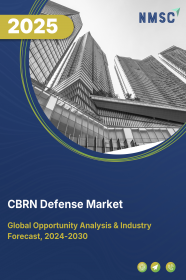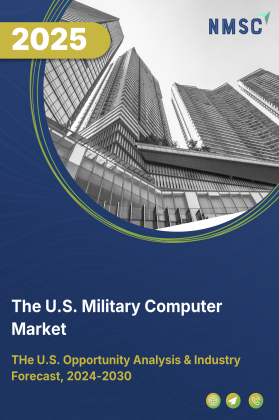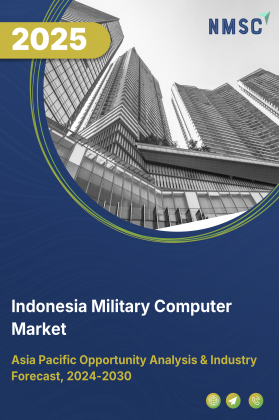
CBRN Defense Market by Threat Type (Chemical, Biological, Radiological, Nuclear, and Explosive), by Products (Personal Protective Equipment (PPE), Detection & Monitoring Systems, Decontamination Systems, and Command, Control, & Software), by Purpose (Detection, Protection, Decontamination & Restoration, Command, Control & Information Management, and Training & Preparedness), and by End User (Government, and Civil & Commercial) – Global Opportunity Analysis and Industry Forecast, 2025–2030
CBRN Defense Market Overview
The global CBRN Defense Market size was valued at USD 17.73 billion in 2024 and is predicted to reach USD 18.76 billion by the end of 2025. The industry is predicted to reach USD 24.87 billion by 2030 with a CAGR of 5.8% from 2025-2030.
The CBRN defense market is growing due to rising global security concerns, advancements in detection and protection technologies, and strong government investments. Geopolitical tensions, regional conflicts, and terrorism threats drive the need for robust defense capabilities to protect both military and civilians. Key advancements in technology improve detection, protection, and decontamination. However, high costs associated with developing and maintaining these technologies limit adoption, particularly in developing nations. On the other nation, opportunities exist in the development of advanced medical countermeasures, which contribute to overall market growth and preparedness.
Escalating Global Security Environment Drives the Market Growth
One of the most significant factors driving the CBRN defense market is the escalating global security environment, characterized by rising geopolitical tensions, regional conflicts, and the ever-present threat of terrorism. This instability increases the perceived risk of CBRN weapons being used, whether by state actors or non-state entities. The ongoing conflicts and power struggles in various parts of the world underscore the need for robust chemical, biological, radiological, and nuclear defense capabilities to protect both military personnel and civilian populations. For instance, the Indian Army's recent procurement of 223 ACADA systems highlights a direct response to these growing security concerns, aiming to enhance their chemical, biological, radiological, and nuclear defense preparedness. Similarly, NATO's continued focus on chemical, biological, radiological, and nuclear defense and the existence of a multinational chemical, biological, radiological, and nuclear defense battalion demonstrate the collective recognition of this critical threat landscape, thereby fueling the demand and market growth within the chemical, biological, radiological, and nuclear defense industry.
Advancements in CBRN Detection and Protection Technologies Boosts the Market Expansion
The proliferation of CBRN materials, technologies, and expertise is another key driver propelling the growth of the CBRN defense market. The increasing availability of dual-use technologies and the potential for both state and non-state actors to acquire or develop CBRN agents necessitate continuous advancements and investments in defensive measures. The concern over emerging technologies being weaponized for CBRN threats is a significant factor driving research and development efforts. This proliferation necessitates enhanced detection capabilities, improved protective measures, and effective decontamination strategies, all of which contribute to the expanding market size and create sustained demand for innovative chemical, biological, radiological, and nuclear defense solutions across various sectors.
Government Investments in CBRN Defense Drives the Market Expansion
Government initiatives and substantial financial investments are crucial in driving the CBRN defense industry forward. Recognizing the catastrophic potential of CBRN attacks, nations worldwide are increasingly prioritizing the strengthening of their chemical, biological, radiological, and nuclear defense infrastructure. This includes allocating significant funding for research and development, procurement of advanced equipment, and the establishment of specialized chemical, biological, radiological, and nuclear defense units and training programs. Organizations like the DRDO (Defence Research and Development Organisation) in India are actively involved in developing indigenous chemical, biological, radiological, and nuclear defense technologies. Furthermore, international collaborations and strategic partnerships among nations, such as within NATO, underscore the global commitment to enhancing CBRN security, directly translating into market opportunities and sustained growth for the chemical, biological, radiological, and nuclear defense industry.
High Costs of CBRN Defense Technologies Limit Market Adoption
A significant restraint on the broader expansion of the CBRN defense industry is the high cost associated with the development, acquisition, and maintenance of advanced chemical, biological, radiological, and nuclear defense technologies. Cutting-edge detection systems, sophisticated protective gear (like specialized gas masks and hazmat suits), and effective medical countermeasures require substantial financial investments in research, development, and production. These high costs are a limiting factor for some nations, particularly developing countries, or smaller organizations, potentially hindering the widespread adoption of state-of-the-art chemical, biological, radiological, and nuclear defense capabilities. This financial constraint influence procurement decisions and potentially slow down the overall market growth rate, despite the recognized critical need for such technologies.
Development of Advanced Defense Medical Countermeasures Presents Market Growth Opportunities
A significant opportunity for industry players in the chemical, biological, radiological, and nuclear defense market lies in the development and deployment of advanced medical countermeasures (MCMs). This encompasses a wide range of products, including prophylactics, therapeutics, and diagnostic tools designed to mitigate the harmful effects of chemical, biological, radiological, and nuclear agents. The increasing awareness of CBRN threats and the potential for mass casualty events have heightened the demand for effective medical solutions.
In 2024, Scorpius BioLogics joined the Medical CBRN Defense Consortium, launching a pilot program in March 2025 with the U.S. Army to produce monoclonal antibodies targeting nerve agents, enhancing chemical threat response capabilities. In October 2023, the Biomedical Advanced Research and Development Authority (BARDA) expanded its partnership with Sri International to develop rapid diagnostic assays for detecting ricin and botulinum toxins, improving early identification of biological threats. Additionally, in 2024, BARDA supported the RAIDR program, repurposing FDA-approved drugs for nerve agent exposure, accelerating MCM development for chemical threats. These initiatives present substantial growth potential for pharmaceutical companies, biotechnology firms, and research institutions, offering a vital contribution to overall CBRN preparedness and resilience, and representing a significant market segment within the broader chemical, biological, radiological, and nuclear defense industry.
Market Segmentation and Scope of Study
The CBRN (Chemical, Biological, Radiological, Nuclear, and Explosive) defense equipment market report is segmented on the basis of type, equipment, purpose, end user, and regions. On the basis of type, the market is categorized into chemical, biological, radiological, nuclear, and explosive. On the basis of equipment, the market is divided into protective wearables, respiratory systems, detection and monitoring systems, decontamination systems, simulators, and information management software. Protective wearables are further segmented into protective clothing, protective gas masks and hoods, escape devices/hoods, protective shoes, and protective gloves. Respiratory systems are categorized into self-contained breathing apparatus (SCBA) and powered air-purifying respirator (PAPR). Detection and monitoring systems are segmented into thermal imagers and sensors. Sensors further divided into stationary and mobile monitoring devices, sampling equipment, screening test kits, infrared spectroscopy, beacons, stand-off detectors, gas detectors, biological threat detectors, and radiological threat detectors. Decontamination systems include contamination indicator decontamination assurance systems, spray units, and others. On the basis of purpose, the market is segmented into detection, protection, decontamination, and simulation and training. On the basis of end user, the market is divided into defense and government, and civil and commercial. The defense and government segment includes armed forces, which is further categorized into air force, army, navy, and others, as well as homeland security, which is segmented into police and fire safety department. The civil and commercial segment includes critical infrastructure, medical, and industrial applications. Regional breakdown and analysis of each of the aforesaid segments includes regions comprising North America, Europe, Asia-Pacific, and RoW.
Geographical Analysis
North America remains a dominant force in the chemical, biological, radiological, and nuclear defense market, driven by significant government investment in chemical, biological, radiological, and nuclear defense technologies and the presence of key industry players and research institutions. The U.S. government plays a central role, with major initiatives such as the involvement of the U.S. Space Force in advancing chemical, biological, radiological, and nuclear defense capabilities and the establishment of specialized chemical, biological, radiological, and nuclear defense units. The activities of organizations like the Medical CBRN Defense Consortium further emphasize the focus on preparedness and innovation in the region. Additionally, the development of advanced chemical, biological, radiological, and nuclear defense systems such as the U.S. Army's Next Generation Chemical Detector (NGCD) highlights the ongoing efforts to enhance detection, protection, and decontamination capabilities, strengthening national security against potential CBRN threats.
Europe showcases a robust approach to CBRN defense through multinational collaborations and national initiatives. NATO's focus on CBRN defense, exemplified by its Multinational CBRN Defence Battalion, underscores the importance of collective defense capabilities. Countries like Finland and Germany, with the Bundeswehr CBRN Defence Command, are investing in the development of advanced technologies to strengthen their national defense systems. Furthermore, European companies are contributing to the market by innovating new solutions, such as drone-based CBRN detection systems, which enhance the region's overall chemical, biological, radiological, and nuclear defense capabilities. This collective commitment to chemical, biological, radiological, and nuclear defense demonstrates Europe’s strategic focus on mitigating CBRN threats and advancing its defensive infrastructure.
Asia-Pacific is witnessing a significant surge in CBRN defense investments, driven by escalating regional security concerns and rising defense budgets in countries like China, India, and Japan. These countries are increasing their focus on enhancing their defense capabilities, particularly in CBRN defense, through the development and acquisition of advanced technologies. India, for example, has been actively strengthening its chemical, biological, radiological, and nuclear defense systems through the procurement of advanced systems like ACADA and significant contributions from the Defence Research and Development Organisation (DRDO). Australia’s focus on CBRN research further underscores the growing importance of this sector in the region. Additionally, the presence of key market players like Bertin Environics, Elbit Systems Ltd., and Nippon Kayaku Co., Ltd. is accelerating the market’s growth by expanding chemical, biological, radiological, and nuclear defense infrastructure and improving the detection and identification of potential CBRN threats in the region.
In the Rest of the World, there is a growing awareness and prioritization of CBRN security, although the level of investment and capabilities varies by region. The increasing importance of CBRN defense is evident in regions like the Middle East, where countries such as Saudi Arabia are enhancing their defense systems in response to emerging threats. While specific details on the market size in these regions are less accessible, there is a general trend toward recognizing the need for advanced chemical, biological, radiological, and nuclear defense technologies. Governments and international collaborations are beginning to focus on improving CBRN detection, protection, and response systems, ensuring better preparedness in the face of chemical, biological, radiological, and nuclear risks.
Strategic Innovations Adopted by Key Players
Key players in the chemical, biological, radiological, and nuclear (CBRN) defense industry is advancing detection, monitoring, and protective measures to counter evolving threats. Emerging technologies, such as AI and drone-based systems, are being integrated for early detection and rapid response. Companies like Smiths Detection are partnered with RiskAware to develop UrbanAware, a CBRN threat intelligence system integrating real-time data and analytics. Cherming Group expanded into energetics and countermeasures, including orders for anti-tank missile components and explosives. AirBoss Defense Group continues to supply advanced protective solutions, focusing on respiratory and protective equipment for military and emergency response units. Challenges include high costs for research, development, and deployment, as well as the need for interoperability across national forces. Opportunities lie in developing medical countermeasures, with initiatives like the Medical CBRN Defense Consortium, including Scorpius BioLogics, advancing vaccines and therapeutics. Realistic training and simulation programs, such as those from NCT-CBNW, also offer growth potential. Ongoing government investments and global initiatives continue to drive market expansion.
Key Benefits
-
The report provides quantitative analysis and estimations of the CBRN defense market from 2025 to 2030, which assists in identifying the prevailing market opportunities.
-
The study comprises a deep-dive analysis of the CBRN defense market including the current and future trends to depict prevalent investment pockets in the market.
-
Information related to key drivers, restraints, and opportunities and their impact on the CBRN defense market is provided in the report.
-
Competitive analysis of the players, along with their market share is provided in the report.
-
SWOT analysis and Porters Five Forces model is elaborated in the study.
-
Value chain analysis in the market study provides a clear picture of roles of stakeholders.
CBRN Defense Market Key Segments
By Threat Type
-
Chemical
-
Biological
-
Radiological
-
Nuclear
-
Explosive
By Product
-
Personal Protective Equipment (PPE)
-
Protective Clothing
-
Respiratory Protection
-
Self-Contained Breathing Apparatus (SCBA)
-
Powered Air-Purifying Respirator (PAPR)
-
-
Protective Gloves
-
Protective Footwear
-
Other PPE
-
-
Detection & Monitoring Systems
-
Chemical Detection Systems
-
Biological Detection Systems
-
Radiological/Nuclear Detection Systems
-
Integrated Sensor Networks & CBRN Reconnaissance Platforms
-
-
Decontamination Systems
-
Decontamination Units & Spray Systems
-
Contamination Indicator & Assurance Systems (CIDS)
-
Waste Neutralization & Disposal Systems
-
Decontamination Consumables
-
-
Command, Control, & Software (C2/Software)
-
Information Management & Decision Support Systems
-
CBRN Modeling, Simulation & Training Software
-
C2 System Integration Platforms
-
By Purpose
-
Detection
-
Protection
-
Decontamination & Restoration
-
Command, Control & Information Management
-
Training & Preparedness
By End User
-
Government
-
Armed Forces
-
Air Force
-
Army
-
Navy
-
Others
-
-
Civil Government & First Responders
-
Homeland Security & Border Protection
-
Police & Law Enforcement
-
Fire & Rescue Services
-
Emergency Management & Public Health Agencies
-
-
-
Civil & Commercial
-
Critical Infrastructure
-
Energy
-
Transportation
-
Water Treatment Facilities
-
-
Healthcare
-
Industrial
-
Private Security & Large Enterprises
-
By Region
-
North America
-
The U.S.
-
Canada
-
Mexico
-
- Europe
-
U.K.
-
Germany
-
France
-
Italy
-
Spain
-
Sweden
-
Denmark
-
Finland
-
Netherlands
-
Rest of Europe
-
-
Asia-Pacific
-
China
-
India
-
Japan
-
South Korea
-
Taiwan
-
Indonesia
-
Vietnam
-
Australia
-
Philippines
-
Malaysia
-
Rest of Asia-Pacific
-
-
Middle East & Africa
-
Saudi Arabia
-
UAE
-
Egypt
-
Israel
-
Turkey
-
Nigeria,
-
South Africa
-
Rest of Middle East & Africa
-
- Latin America
-
Brazil
-
Argentina
-
Chile
-
Colombia
-
Rest of Latin America
-
Key Players
-
Smiths Detection
-
Bruker Corporation
-
FLIR Systems (Teledyne FLIR)
-
Chemring Group
-
Avon Protection
-
AirBoss Defense Group
-
Honeywell International
-
Battelle
-
Leidos
-
Northrop Grumman
-
Lockheed Martin Corporation
-
Drägerwerk AG & Co. KGaA
-
Kärcher Futuretech GmbH
-
PROENGIN
-
Mirion Technologies
-
HDT Global
-
Argon Electronics
-
Saab AB
-
Rheinmetall
-
BioFire Defense
Report Scope and Segmentation
|
Parameters |
Details |
|
Market Size in 2024 |
USD 17.73 Billion |
|
Revenue Forecast in 2030 |
USD 24.87 Billion |
|
Growth Rate |
CAGR of 5.8% from 2025 to 2030 |
|
Analysis Period |
2024–2030 |
|
Base Year Considered |
2024 |
|
Forecast Period |
2025–2030 |
|
Market Size Estimation |
Billion (USD) |
|
Growth Factors |
|
|
Countries Covered |
28 |
|
Companies Profiled |
20 |
|
Market Share |
Available for 10 companies |
|
Customization Scope |
Free customization (equivalent to up to 80 working hours of analysts) after purchase. Addition or alteration to country, regional, and segment scope. |
|
Pricing and Purchase Options |
Avail customized purchase options to meet your exact research needs. |

















 Speak to Our Analyst
Speak to Our Analyst

























